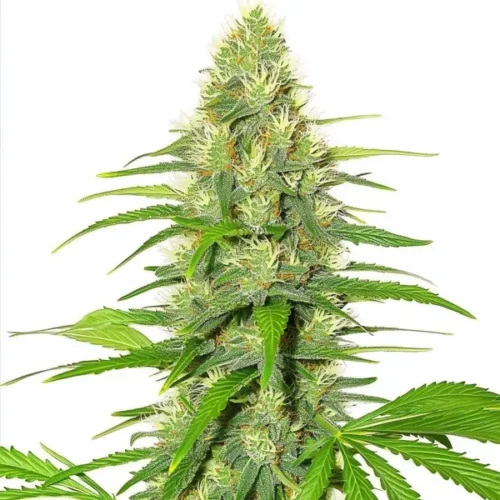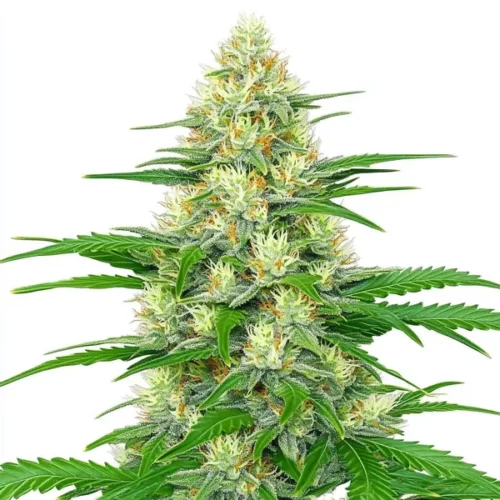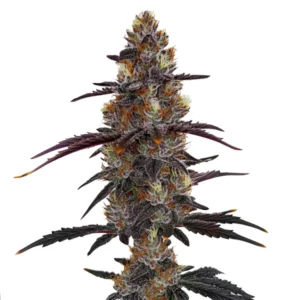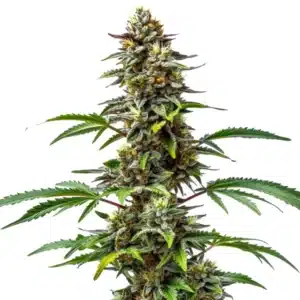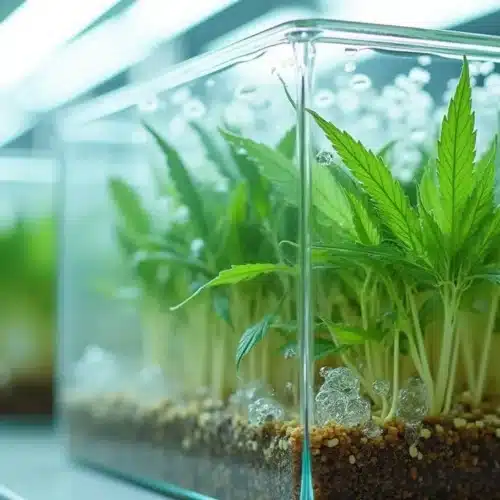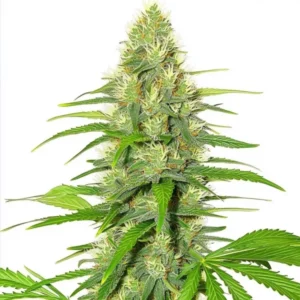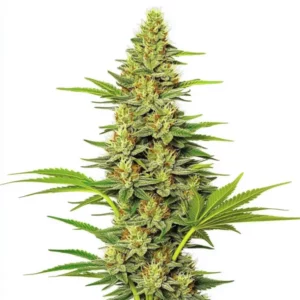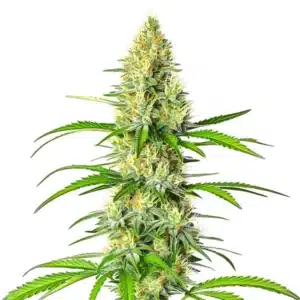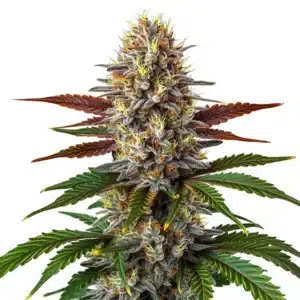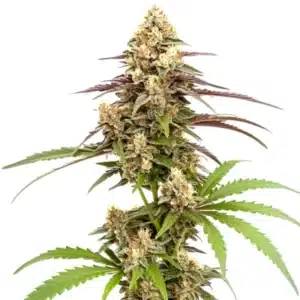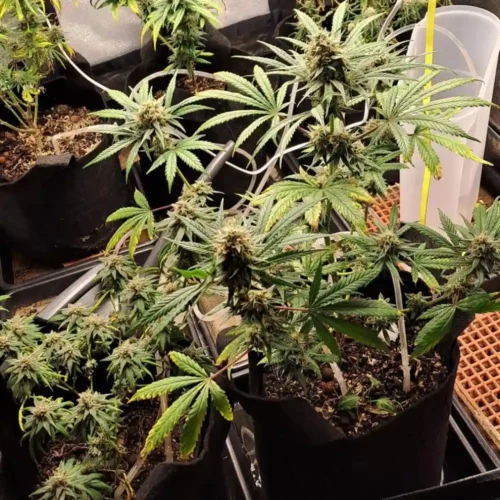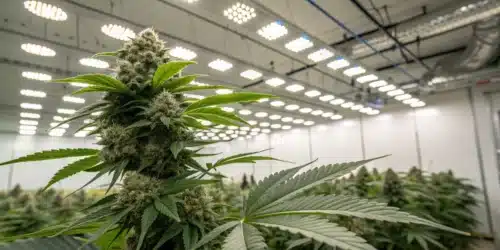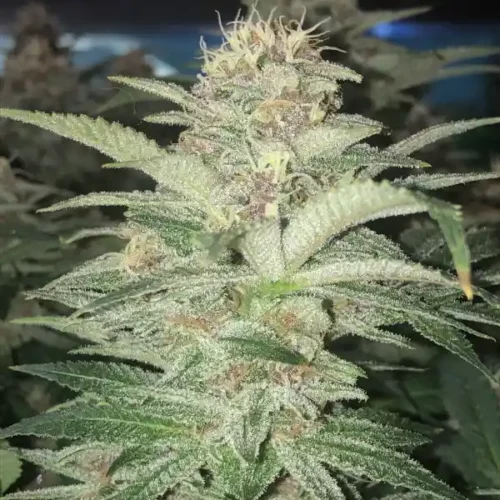White Widow Strain Seeds Description
The cannabis White Widow Strain is a highly sought-after cannabis strain that has gained immense popularity among cannabis enthusiasts. Known for its unique combination of aroma, flavor, and effects, this strain has become a favorite among both recreational and medicinal users.
White Widow is a hybrid strain that originated in the Netherlands. It typically features dense, resinous buds with a frosty appearance due to the abundant trichome coverage. The strain’s name comes from the white, crystal-like resin that coats the buds. The buds, known as the white widow flower, develop a unique aroma and flavor as they mature.
Recommended Strains
White Widow
 THC: 18% - 25%
THC: 18% - 25% Type of seed: Feminized
Type of seed: Feminized Phenotype: Mostly Sativa
Phenotype: Mostly Sativa Day to flower: 8 - 10 weeks
Day to flower: 8 - 10 weeks
White Widow Autoflower
 THC: 20 - 25
THC: 20 - 25 Type of seed: Autoflowering
Type of seed: Autoflowering Phenotype: Mostly Sativa
Phenotype: Mostly Sativa Day to flower: 8 - 10 weeks
Day to flower: 8 - 10 weeks
One of the distinguishing features of this Strain is its balanced hybrid nature, offering a mix of Indica and Sativa characteristics. It provides a well-rounded and enjoyable experience for users. Follow our comprehensive white widow grow guide detailed below to help you get started.
Promos & Deals
Environmental Requirements for Growing White Widow Marijuana
Creating the ideal environment for your White Widow Strain plants is crucial to ensure their optimal growth and development. The environmental requirements of this strain will help you provide the best conditions for a successful cultivation process.
White Widow thrives in a temperate climate, with temperatures ranging between 70-80°F (21-27°C) during the day and slightly cooler temperatures at night. It is essential to maintain a stable temperature and humidity level within the grow space to prevent stress or potential issues such as mold or mildew.
For a succesful white widow grow indoors, providing adequate lighting is crucial. High-quality LED grow lights or HPS lamps are recommended to ensure proper photosynthesis and robust bud development. During the vegetative phase, provide a light cycle of 18-20 hours of light per day, and switch to 12 hours of light and 12 hours of uninterrupted darkness to initiate flowering.
For outdoor cultivation, choose a location with ample sunlight and a favorable climate. White Widow Strain thrives in a sunny and warm environment, allowing it to reach its full potential. If you live in a region with cooler climates, consider using a greenhouse or providing additional protection to extend the growing season and safeguard your plants from adverse weather conditions. Select white widow feminized seeds to ensure the best possible outcome.
Setting Up The Growing Cannabis Space for White Widow Strain
Before you begin growing White Widow, it is essential to set up an efficient and well-organized growing space. Whether you choose to cultivate indoors or outdoors, the following factors should be considered:
Indoor Cannabis Cultivation
For indoor growers, selecting the right grow tent or dedicated grow room is crucial. Ensure that the space provides sufficient room for the plants to grow vertically and has proper ventilation to maintain a fresh airflow. Install an efficient exhaust system with a carbon filter to control odors and prevent the accumulation of heat or humidity. Use reflective materials or Mylar sheets to maximize light distribution and avoid light leaks that could disrupt the flowering phase.
Choose a suitable growing medium for this Strain, such as high-quality soil or a hydroponic system, depending on your preferences and experience. Ensure proper drainage to prevent waterlogging and maintain a balanced pH level of around 6.0-6.5 for optimal nutrient absorption.
Outdoor Cannabis Cultivation
When cultivating White Widow Strain outdoors, select a location with plenty of sunlight and suitable soil conditions. Ensure the soil is well-draining and rich in organic matter. Consider using large containers or fabric pots to have better control over soil quality and root health. Additionally, protect your plants from strong winds by placing them near a fence or using windbreaks.
Using stakes or trellises to support the branches of your White Widow Strain plants is recommended. This helps prevent the branches from bending or breaking under the weight of the dense buds and promotes better airflow.
Propagation and Germination of White Widow Seeds
Successful germination and propagation are essential for healthy and vigorous White Widow plants. Follow these steps to ensure a high germination rate and successful propagation:
1. Start by selecting high-quality White Widow seeds from a reputable seed bank. This ensures genetic stability and the feminization of your plants.
2. Begin the germination process by soaking the seeds in distilled water or a damp paper towel for 24-48 hours. Maintain a temperature between 70-85°F (21-29°C) and provide a dark and undisturbed environment.
3. After the seeds have soaked and developed taproots, transfer them carefully to a pre-moistened growing medium, such as a seedling tray or small pots filled with a light and well-draining soil mix.
4. Place the seeds in a warm and humid environment with gentle airflow. Maintain a temperature around 75-80°F (24-27°C) and a humidity level of 60-70% for optimal germination.
5. Provide indirect light to the seedlings during the first few days, gradually increasing the light intensity as they develop. Avoid exposing them to intense light or heat that could cause stress or damage.
6. Once the seedlings have developed a few sets of true leaves, they are ready to be transplanted into larger pots or the final growing containers.
By following these germination and propagation steps, you can ensure a successful start for this Strain plants and establish a strong foundation for healthy growth and abundant yields.
Vegetative Phase of White Widow seeds
The vegetative phase is a crucial stage in the development of your White Widow Strain plants. Here are some key considerations during this phase:
Lighting: Provide your White Widow plants with 18-20 hours of light per day to promote vigorous vegetative growth. High-quality LED grow lights or HPS lamps are recommended to ensure sufficient light intensity and spectral distribution.
Nutrition: During the vegetative phase, this Strain plants require a balanced and nutrient-rich diet. Use a reputable cannabis fertilizer with a higher nitrogen (N) content to encourage healthy leaf and stem growth. Follow the manufacturer’s instructions and monitor the plants for any signs of nutrient deficiencies or excesses.
Watering: Water your plants when the top inch of the soil feels dry. Avoid overwatering, as it can lead to root rot and other moisture-related issues. Allow the soil to dry out slightly between watering sessions, but ensure the plants do not experience extreme drought.
Training: Consider employing training techniques such as low-stress training (LST) or topping to control the height and shape of your White Widow Strain plants. These methods help create an even canopy, increase light penetration, and promote better bud development.
Pruning: Remove any lower branches or leaves that receive little light or show signs of disease or pests. This helps improve airflow and reduces the risk of mold or mildew formation.
By providing your White Widow plants with the right environmental conditions, nutrition, and care during the vegetative phase, you can establish healthy and robust plants ready for the flowering stage.
Flowering Phase of White Widow Seeds
The flowering phase is the most anticipated stage of growing this Strain, as it is when the plants develop their characteristic buds. Here’s what you need to know:
Lighting: Adjust the light cycle to 12 hours of light and 12 hours of uninterrupted darkness to initiate the flowering phase. Use a timer to maintain a consistent light schedule. During this stage, your White Widow Strain plants require intense light, so ensure your grow lights provide adequate coverage and maintain the appropriate distance from the canopy.
Nutrition: Transition from a nutrient formula higher in nitrogen to a bloom or flowering-specific nutrient formula. These formulations are generally higher in phosphorus (P) and potassium (K), which promote bud development and overall flowering performance. Monitor the plants closely and adjust nutrient levels as needed to avoid deficiencies or toxicities.
Temperature and Humidity: Maintain a slightly lower temperature during the flowering phase, ideally around 65-75°F (18-24°C), to encourage resin production and prevent heat-related stress. As for humidity, aim for levels around 40-50% to minimize the risk of mold or bud rot.
Support: As your White Widow plants enter the flowering phase, the weight of the developing buds may cause branches to bend or break. Provide adequate support using stakes or trellises to ensure the plants can bear the weight and avoid bud damage.
Flowering Time: This Strain typically has a flowering time of 8-10 weeks, but this can vary depending on the specific phenotype and environmental conditions. Monitor the trichome development using a magnifying tool to determine the optimal harvest window.
Throughout the flowering phase, maintain a vigilant eye for any signs of pests or diseases. Implement proper pest management practices and take immediate action at the first sight of infestation or abnormalities.
Cannabis Fertilization and Nutrition – White Widow Strain
Proper nutrition and fertilization are crucial for maximizing the growth, yield, and overall health of your White Widow plants. Consider the following tips:
Choosing the Right Fertilizer: Select a high-quality cannabis-specific fertilizer or nutrient line that provides a balanced blend of macro and micronutrients. Look for products rich in nitrogen (N), phosphorus (P), and potassium (K) to support healthy growth, root development, and bud formation.
Feeding Schedule: Follow the manufacturer’s instructions and adjust the feeding schedule based on your plants’ specific needs. Start with a lower concentration and gradually increase it as the plants progress through their growth stages. Monitor the plants closely for any signs of nutrient deficiencies or excesses, and make adjustments accordingly.
Supplements and Additives: Consider incorporating supplements and additives into your feeding regimen to enhance specific aspects of plant development. These may include bloom boosters, beneficial microbes, enzymes, or organic amendments that improve soil structure and nutrient availability.
Regularly monitor your plants’ response to the feeding program, adjusting nutrient concentrations and frequencies as needed. Remember to flush the plants with pure water during the final weeks of the flowering phase to remove any excess salts or nutrients, which can affect the flavor and overall quality of the final harvest.

Pest And Disease Control for Cannabis Growing – White Widow Strain
While this Strain is known for its resilience, it is still susceptible to pests and diseases. Implementing proper pest and disease control measures is crucial to protect your plants and ensure a successful cultivation. Here are some preventive and corrective actions:
Prevention:
- Regularly inspect your plants for any signs of pests, such as spider mites, aphids, or thrips. Early detection is key to preventing a full-blown infestation.
- Maintain a clean and tidy growing space, removing any dead plant material or debris that could harbor pests or pathogens.
- Introduce beneficial insects, such as ladybugs or predatory mites, to your garden to help control pests naturally.
- Ensure proper airflow and ventilation in the growing space to reduce the risk of mold or mildew formation.
- Quarantine new plants or clones before introducing them into your growing area to prevent the spread of pests or diseases.
Corrective Actions:
- If you detect pests, use organic or low-toxicity pest control products specifically formulated for cannabis. Follow the instructions carefully and avoid using harsh chemicals that can compromise the quality of your harvest.
- For common fungal diseases like powdery mildew or botrytis, remove infected plant material, increase airflow, and consider using organic fungicides or natural remedies such as neem oil or a milk spray solution.
- When dealing with severe infestations or persistent diseases, consult with a professional grower or horticulturist for tailored advice and appropriate solutions.
Harvesting and Curing for Cannabis Growing – White Widow
Harvesting and curing this Strain buds correctly is essential to preserve their quality, flavor, and potency. Follow these steps for a successful harvest and curing process:
Harvesting:
1. Determine the optimal harvest time by observing the trichomes. Look for mostly cloudy trichomes with a few amber ones. This indicates the ideal time for harvesting, which typically occurs 8-10 weeks into the flowering phase.
2. Use sharp, clean pruning shears or scissors to cut the branches with mature buds. Handle the buds gently to avoid damaging the trichomes.
3. Hang the harvested branches upside down in a dark and well-ventilated room with a temperature of around 60-70°F (15-21°C) and a humidity level of 45-55%. Proper ventilation is crucial to prevent mold or mildew formation.
4. Allow the buds to dry for about 7-10 days, or until the smaller stems snap instead of bending. This indicates that the buds are sufficiently dried.
Curing:
1. Once the buds are sufficiently dried, carefully remove them from the branches and place them in airtight glass jars. Fill the jars about 2/3 full to leave some air space.
2. Store the jars in a cool, dark, and dry place with a consistent temperature of 60-65°F (15-18°C). Use a hygrometer to monitor the humidity level inside the jars.
3. During the curing process, open the jars once a day for the first week to release excess moisture and promote proper curing. After the first week, you can reduce the frequency to every few days, then weekly, as the curing process progresses.
4. Curing typically takes 2-4 weeks, but longer curing can further enhance the flavor and smoothness of the buds. Some growers even opt for several months of curing for the best results.
5. Properly cured White Widow Strain buds will have a smoother smoke, a well-rounded flavor profile, and a balanced high. They will also have a reduced “green” or grassy taste often associated with freshly harvested cannabis.
White Widow Strain Indica or Sativa?
This Strain is a hybrid cannabis strain that exhibits characteristics of both Indica and Sativa genetics. It is renowned for its balanced effects, making it a versatile choice for a wide range of users.
While the exact genetic makeup may vary depending on the breeder and phenotype, White Widow Strain typically contains a nearly equal blend of Indica and Sativa genetics. This balance results in a well-rounded high that combines the relaxing, body-centric effects of Indica with the uplifting and cerebral qualities of Sativa.
When consuming White Wido, users often experience a sense of relaxation, euphoria, and mental clarity. It can be suitable for both daytime and evening use, depending on the individual’s tolerance and preferences.
Advantages of Growing White Widow Seeds
Growing this Strain cannabis seeds offers several advantages that make it an appealing choice for cultivators:
- High-Yielding: White Widow Strain is known for its generous yields of resinous buds, making it a profitable choice for growers.
- Resilience: This strain is relatively resistant to pests, diseases, and environmental stressors, making it suitable for both novice and experienced growers.
- Balanced Effects: White Widow provides a balanced high that combines the best of both Indica and Sativa genetics, offering relaxation and mental clarity.
- Short Flowering Time: With a flowering time of 8-10 weeks, this Strain allows for a relatively quick turnaround compared to some other strains.
- Popular Strain: ThisStrain is well-known and highly sought after, making it easy to find in seed banks and dispensaries.
Disadvantages of Growing White Widow Seeds
While this Strain offers many advantages, it also has some potential disadvantages that growers should consider:
- Moderate Difficulty: Although it’s not overly challenging, White Widow Strain may require some experience to maximize its potential, especially when it comes to nutrient management and trimming.
- Odor Control: The strain can produce a strong and pungent aroma during flowering, so effective odor control measures may be necessary for indoor cultivation.
- Space Requirements: White Widow can grow tall and bushy, so indoor growers with limited space may need to employ training techniques or grow smaller varieties.
Why buy White Widow Seeds
There are several compelling reasons to consider buying White Widow Strain marijuana seeds:
- Quality Genetics: Purchasing seeds from reputable seed banks ensures that you receive high-quality genetics with genetic stability and feminization.
- Variety of Phenotypes: White Widow seeds may produce various phenotypes, allowing you to explore different expressions of this classic strain.
- Control and Selection: By growing from seeds, you have more control over the cultivation process and can select the healthiest and most promising plants for your garden.
- Legal Compliance: Buying seeds from a legitimate source can help ensure that you comply with your region’s cannabis laws and regulations.
Purchase your white widow cannabis seeds from our reliable source for a healthy start.
Problems in Cultivating White Widow Seeds
While this Strain is known for its resilience, growers may encounter some common issues during cultivation:
- Pest Infestations: Spider mites, aphids, and other pests can occasionally affect White Widow plants. Regular monitoring and preventive measures are essential.
- Nutrient Imbalances: Incorrect nutrient levels or imbalances can lead to nutrient deficiencies or toxicities. Monitor your plants and adjust nutrient levels accordingly.
- Mold and Mildew: High humidity levels or poor ventilation can result in mold or mildew growth on the buds. Maintain proper environmental conditions to prevent these issues.
- Overwatering or Underwatering: Finding the right balance of watering is crucial. Overwatering can lead to root rot, while underwatering can stress the plants.
- Flowering Stretch: Some White Widow Strain phenotypes may exhibit a significant flowering stretch, causing the plants to double in size during the early flowering phase. Plan your space accordingly.
Note that ‘white window weed’ is sometimes mistakenly used to refer to white widow, but the correct term is white widow cannabis.
Growing this Strain cannabis seeds can be a rewarding experience, provided you follow proper cultivation practices and address potential challenges along the way. This versatile and balanced hybrid offers the best of both Indica and Sativa genetics, making it a popular choice among growers and consumers alike. Whether you’re a novice or experienced cultivator, cultivating White Widow Strain can lead to a bountiful harvest of resinous, high-quality buds that deliver a well-rounded and enjoyable cannabis experience.
If you have any more specific questions or need further guidance on any aspect of growing White Widow, feel free to ask. Happy growing!
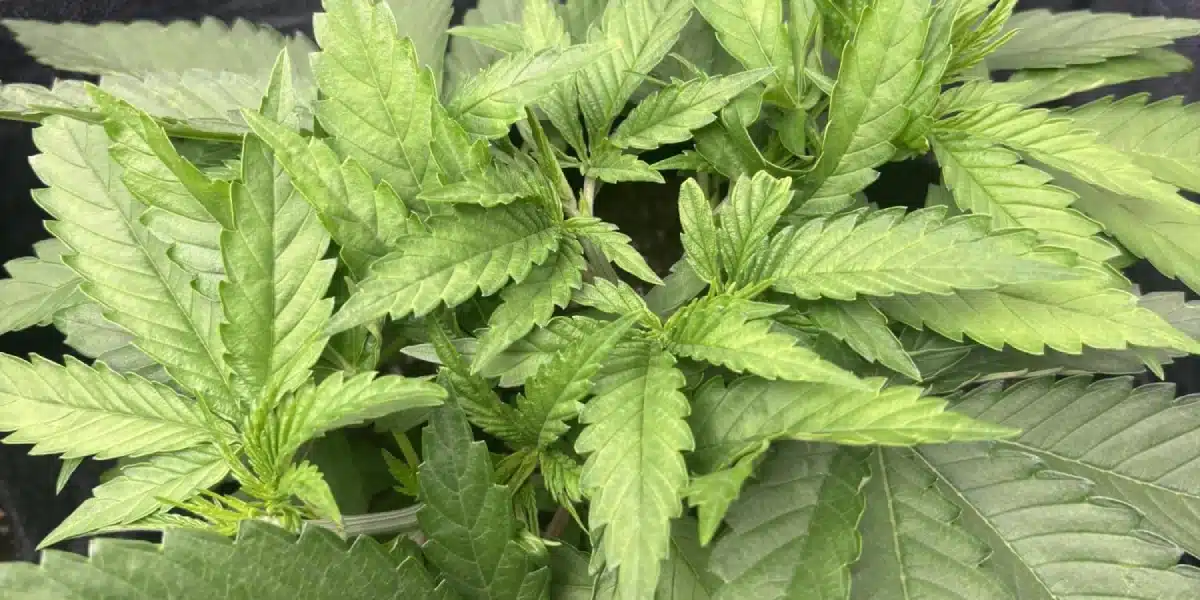
FAQs about White Widow
What are the ideal environmental conditions for growing White Widow?
To successfully cultivate White Widow, maintain daytime temperatures between 70-80°F (21-27°C) and slightly cooler nights. Keeping humidity levels around 40-50% during the flowering stage helps prevent mold and mildew, while ensuring proper ventilation and using quality LED or HPS grow lights will promote healthy plant development.
How do I start the germination process for White Widow cannabis seeds?
Begin by soaking high-quality White Widow cannabis seeds—preferably feminized—in distilled water or between damp paper towels for 24-48 hours. Keep the seeds in a warm (70-85°F or 21-29°C), dark, and undisturbed environment until taproots emerge. Once germinated, carefully transplant the seeds into a well-draining growing medium to ensure optimal growth.
What nutrient and watering guidelines should I follow during the vegetative and flowering stages?
During the vegetative phase, use a balanced nutrient regimen high in nitrogen to support robust leaf and stem growth, watering only when the top inch of soil feels dry. As your plants transition to flowering, switch to a nutrient formula higher in phosphorus and potassium to encourage bud development, and adjust watering practices to avoid overwatering and root rot.

